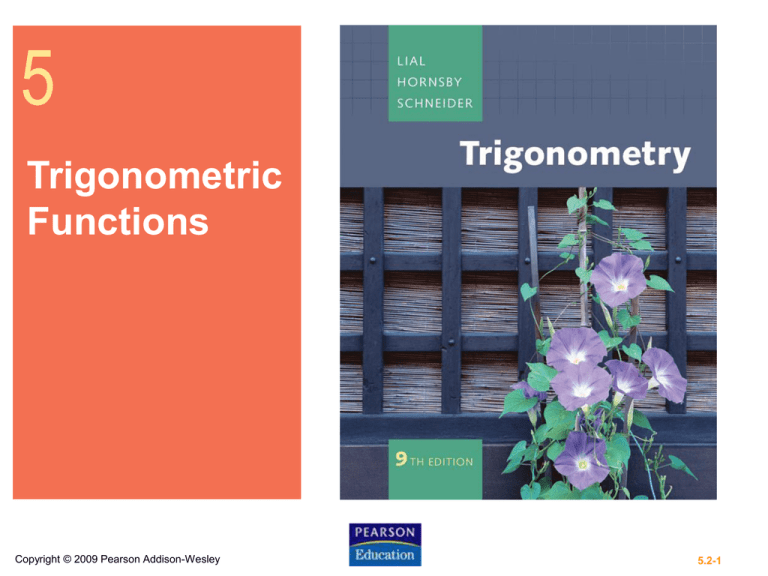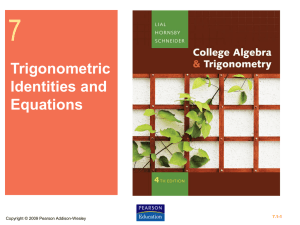
5
Trigonometric
Functions
Copyright © 2009 Pearson Addison-Wesley
5.2-1
5 Trigonometric Functions
5.1 Angles
5.2 Trigonometric Functions
5.3 Evaluating Trigonometric Functions
5.4 Solving Right Triangles
Copyright © 2009 Pearson Addison-Wesley
5.2-2
5.2 Trigonometric Functions
Trigonometric Functions ▪ Quadrantal Angles ▪ Reciprocal
Identities ▪ Signs and Ranges of Function Values ▪ Pythagorean
Identities ▪ Quotient Identities
Copyright © 2009 Pearson Addison-Wesley
1.1-3
5.2-3
Trigonometric Functions
Let (x, y) be a point other the origin on the terminal
side of an angle in standard position. The
distance from the point to the origin is
Copyright © 2009 Pearson Addison-Wesley
5.2-4
Trigonometric Functions
The six trigonometric functions of θ are
defined as follows:
Copyright © 2009 Pearson Addison-Wesley
1.1-5
5.2-5
Example 1
FINDING FUNCTION VALUES OF AN
ANGLE
The terminal side of angle in standard position
passes through the point (8, 15). Find the values of
the six trigonometric functions of angle .
Copyright © 2009 Pearson Addison-Wesley
1.1-6
5.2-6
Example 1
Copyright © 2009 Pearson Addison-Wesley
FINDING FUNCTION VALUES OF AN
ANGLE (continued)
1.1-7
5.2-7
Example 2
FINDING FUNCTION VALUES OF AN
ANGLE
The terminal side of angle in standard position
passes through the point (–3, –4). Find the values
of the six trigonometric functions of angle .
Copyright © 2009 Pearson Addison-Wesley
1.1-8
5.2-8
Example 2
FINDING FUNCTION VALUES OF AN
ANGLE (continued)
Use the definitions of the trigonometric functions.
Copyright © 2009 Pearson Addison-Wesley
1.1-9
5.2-9
Example 3
FINDING FUNCTION VALUES OF AN
ANGLE
Find the six trigonometric function values of the
angle θ in standard position, if the terminal side of θ
is defined by x + 2y = 0, x ≥ 0.
We can use any point on
the terminal side of to
find the trigonometric
function values.
Choose x = 2.
Copyright © 2009 Pearson Addison-Wesley
1.1-10
5.2-10
Example 3
FINDING FUNCTION VALUES OF AN
ANGLE (continued)
The point (2, –1) lies on the terminal side, and the
corresponding value of r is
Multiply by
to rationalize
the denominators.
Copyright © 2009 Pearson Addison-Wesley
1.1-11
5.2-11
Example 4(a) FINDING FUNCTION VALUES OF
QUADRANTAL ANGLES
Find the values of the six trigonometric functions for
an angle of 90°.
The terminal side passes
through (0, 1). So x = 0, y = 1,
and r = 1.
undefined
Copyright © 2009 Pearson Addison-Wesley
undefined
1.1-12
5.2-12
Example 4(b) FINDING FUNCTION VALUES OF
QUADRANTAL ANGLES
Find the values of the six
trigonometric functions for an
angle θ in standard position
with terminal side through
(–3, 0).
x = –3, y = 0, and r = 3.
undefined
Copyright © 2009 Pearson Addison-Wesley
undefined
1.1-13
5.2-13
Undefined Function Values
If the terminal side of a quadrantal angle lies along
the y-axis, then the tangent and secant functions
are undefined.
If the terminal side of a quadrantal angle lies along
the x-axis, then the cotangent and cosecant
functions are undefined.
Copyright © 2009 Pearson Addison-Wesley
1.1-14
5.2-14
Commonly Used Function
Values
sin
cos
tan
cot
sec
csc
0
0
1
0
undefined
1
undefined
90
1
0
undefined
0
undefined
1
180
0
1
0
undefined
1
undefined
270
1
0
undefined
0
undefined
1
360
0
1
0
undefined
1
undefined
Copyright © 2009 Pearson Addison-Wesley
5.2-15
Using a Calculator
A calculator in degree mode
returns the correct values
for sin 90° and cos 90°.
The second screen shows
an ERROR message for tan
90° because 90° is not in
the domain of the tangent
function.
Copyright © 2009 Pearson Addison-Wesley
5.2-16
Caution
One of the most common errors
involving calculators in trigonometry
occurs when the calculator is set for
radian measure, rather than degree
measure.
Copyright © 2009 Pearson Addison-Wesley
1.1-17
5.2-17
Reciprocal Identities
For all angles θ for which both functions are
defined,
Copyright © 2009 Pearson Addison-Wesley
1.1-18
5.2-18
Example 5(a)
USING THE RECIPROCAL IDENTITIES
Since cos θ is the reciprocal of sec θ,
Copyright © 2009 Pearson Addison-Wesley
1.1-19
5.2-19
Example 5(b)
USING THE RECIPROCAL IDENTITIES
Since sin θ is the reciprocal of csc θ,
Rationalize the
denominator.
Copyright © 2009 Pearson Addison-Wesley
1.1-20
5.2-20
Signs of Function Values
in
Quadrant sin cos
tan
cot
sec
csc
I
+
+
+
+
+
+
II
+
+
III
+
+
IV
+
+
Copyright © 2009 Pearson Addison-Wesley
5.2-21
Signs of Function Values
Copyright © 2009 Pearson Addison-Wesley
5.2-22
Example 6
IDENTIFYING THE QUADRANT OF AN
ANGLE
Identify the quadrant (or quadrants) of any angle
that satisfies the given conditions.
(a) sin > 0, tan < 0.
Since sin > 0 in quadrants I and II, and tan < 0 in
quadrants II and IV, both conditions are met only in
quadrant II.
(b) cos < 0, sec < 0
The cosine and secant functions are both negative
in quadrants II and III, so could be in either of
these two quadrants.
Copyright © 2009 Pearson Addison-Wesley
1.1-23
5.2-23
Ranges of Trigonometric
Functions
Copyright © 2009 Pearson Addison-Wesley
1.1-24
5.2-24
Example 7
DECIDING WHETHER A VALUE IS IN
THE RANGE OF A TRIGONOMETRIC
FUNCTION
Decide whether each statement is possible or
impossible.
(a) sin θ = 2.5
Impossible
(b) tan θ = 110.47
Possible
(c) sec θ = .6
Impossible
Copyright © 2009 Pearson Addison-Wesley
1.1-25
5.2-25
Pythagorean Identities
For all angles θ for which the function values are
defined,
Copyright © 2009 Pearson Addison-Wesley
1.1-26
5.2-26
Quotient Identities
For all angles θ for which the denominators are
not zero,
Copyright © 2009 Pearson Addison-Wesley
1.1-27
5.2-27
Example 8
FINDING OTHER FUNCTION VALUES
GIVEN ONE VALUE AND THE
QUADRANT
Find sin θ and cos θ, given that
quadrant III.
and θ is in
Since θ is in quadrant III, both sin θ and cos θ are
negative.
Copyright © 2009 Pearson Addison-Wesley
1.1-28
5.2-28
Example 8
FINDING OTHER FUNCTION VALUES
GIVEN ONE VALUE AND THE
QUADRANT (continued)
Caution
It is incorrect to say that sin θ = –4
and cos θ = –3, since both sin θ and
cos θ must be in the interval [–1, 1].
Copyright © 2009 Pearson Addison-Wesley
1.1-29
5.2-29
Example 8
FINDING OTHER FUNCTION VALUES
GIVEN ONE VALUE AND THE
QUADRANT (continued)
Use the identity
to find sec θ. Then
use the reciprocal identity to find cos θ.
Choose the negative
square root since sec θ <0
for θ in quadrant III.
Secant and cosine are
reciprocals.
Copyright © 2009 Pearson Addison-Wesley
1.1-30
5.2-30
Example 8
FINDING OTHER FUNCTION VALUES
GIVEN ONE VALUE AND THE
QUADRANT (continued)
Choose the negative
square root since sin θ <0
for θ in quadrant III.
Copyright © 2009 Pearson Addison-Wesley
1.1-31
5.2-31
Example 8
FINDING OTHER FUNCTION VALUES
GIVEN ONE VALUE AND THE
QUADRANT (continued)
This example can also be
worked by drawing θ in
standard position in quadrant
III, finding r to be 5, and then
using the definitions of sin θ
and cos θ in terms of x, y,
and r.
Copyright © 2009 Pearson Addison-Wesley
1.1-32
5.2-32







